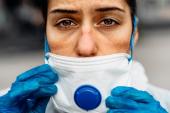COVID-19: TCTMD’s Dispatch for February Week 4
We’re curating a list of COVID-19 research and other useful content, and updating it regularly.

Since March 2020, TCTMD reporter Todd Neale has been writing up breaking news and peer-reviewed research related to COVID-19 every weekday. In July 2021, we transitioned to Mondays, Wednesdays, and Fridays. If you have something to share, tell us. All of our COVID-19 coverage can be found on our COVID-19 Hub.
February 25, 2022
As Ukrainians seek shelter or flee cities and homes in the face of the Russian attack, COVID-19 is likely to add another layer of peril and hardship, a New York Times story details. “The fighting in Ukraine’s east is forcing a mass migration to the west that is crowding mass transit centers and trains and jamming roads. Video images of the large numbers of Ukrainians on the move show understandably few signs of face coverings, even as the country is just getting past a record high point in its infection rate,” Adeel Hassan writes. Neighboring countries can expect to see their COVID numbers rise, as refugees flow into Poland, Hungary, Slovakia, and Romania.
 The COVID-19 pandemic has orphaned more than 5 million children worldwide, an updated modeling study in the Lancet concludes. More tragic still, the number of children left without a parent or caregiver rose steeply—almost doubling from the end of April to October of 2021. The loss of a father was more common than the loss of a mother, and the children most commonly affected were adolescents. “Globally, the heartbreaking hidden pandemic of over 5.2 million children affected by orphanhood and caregiver death has outpaced the 5.0 million COVID-19 deaths,” the authors write. In regions with high fertility rates, the number of children left without a parent has exceeded the number of people dying from the disease itself.
The COVID-19 pandemic has orphaned more than 5 million children worldwide, an updated modeling study in the Lancet concludes. More tragic still, the number of children left without a parent or caregiver rose steeply—almost doubling from the end of April to October of 2021. The loss of a father was more common than the loss of a mother, and the children most commonly affected were adolescents. “Globally, the heartbreaking hidden pandemic of over 5.2 million children affected by orphanhood and caregiver death has outpaced the 5.0 million COVID-19 deaths,” the authors write. In regions with high fertility rates, the number of children left without a parent has exceeded the number of people dying from the disease itself.
The Lancet this week also has a systematic review and meta-regression analysis addressing the question of waning vaccine effectiveness. Its conclusion, based on a detailed review of 18 studies: “COVID-19 vaccine efficacy or effectiveness against severe disease remained high, although it did decrease somewhat by 6 months after full vaccination. By contrast, vaccine efficacy or effectiveness against infection and symptomatic disease decreased approximately 20-30 percentage points by 6 months.”
The US Centers for Disease Control and Prevention (CDC) is planning to ease mask guidelines today, according to multiple reports. According to the Associated Press, citing two anonymous sources, “most Americans will no longer be advised to wear masks in indoor public settings.” Florida, however, is already setting its own course, updating the state’s guidance yesterday with a strategy that Florida Surgeon General Joseph Ladapo, MD, PhD, explicitly describes as “bucking” the CDC advice. Becker’s Hospital Review has the story.
 Other countries have already taken steps to ease restrictions. In the United Kingdom, where mask advice has been eased in recent weeks, Transport for London announced that face masks will no longer be compulsory on trains and buses, although they are still “strongly recommended.” All remaining COVID restrictions, required by law, were lifted in England yesterday, including routine contact tracing and the requirement that people self-isolate after testing positive. Requirements for self-isolation are still in place in Scotland, Wales, and Northern Ireland, a BBC explainer notes.
Other countries have already taken steps to ease restrictions. In the United Kingdom, where mask advice has been eased in recent weeks, Transport for London announced that face masks will no longer be compulsory on trains and buses, although they are still “strongly recommended.” All remaining COVID restrictions, required by law, were lifted in England yesterday, including routine contact tracing and the requirement that people self-isolate after testing positive. Requirements for self-isolation are still in place in Scotland, Wales, and Northern Ireland, a BBC explainer notes.
The European Medicines Agency (EMA) has approved an extension of the indication for Moderna’s COVID-19 vaccine (Spikevax) to include use in children ages 6 to 11. It is already approved for adults and children 12 and above. “As in the older age group, the vaccine is given as two injections in the muscles of the upper arm, 4 weeks apart,” an EMA announcement yesterday stated.
The same day, the EMA also announced that its human medicines committee was recommending booster shots with Pfizer/BioNTech’s vaccine (Comirnaty) for people 12 and up who have already had the two-dose primary course. Previously, boosters had already been authorized for people 18 and older. Those recommendations are similar to those in other parts of the world.
Meanwhile, pediatric emergency department visits declined sharply during the COVID-19 pandemic, an analysis in Morbidity and Mortality Weekly Report makes clear, mirroring the kinds of drops seen for adult critical care. “Compared with 2019, overall pediatric emergency department visits decreased by 51%, 22%, and 23% during 2020, 2021, and January 2022, respectively.” Hospital trips for COVID-19 visits were the most common across all pediatric ages.
In the South African province of Gauteng, two-thirds of unvaccinated residents had already recovered from a prior infection, based on seropositivity for SARS-CoV-2, at the time the Omicron variant hit. That explains in part a “decoupling” of hospitalizations and deaths from infections at the time Omicron was circulating, as a new study of 7,010 participants published in the New England Journal of Medicine shows.
Also in the NEJM, a case-control study of American adolescents (ages 12 to 18) during the Delta surge confirms that vaccination with the Pfizer/BioNTech vaccine was 94% effective in preventing hospitalization and 98% effective against ICU admissions, as well as need for COVID-19 life support. “All seven deaths occurred in patients who were unvaccinated,” the authors point out. An accompanying editorial notes that while childhood vaccination rates in the US surpass 95%, rates of COVID-19 vaccination for children ages 5 to 11 was just 15% as of December 1, 2021. “The achievement of similar vaccination rates for protection against COVID-19 would have an enormous effect on the pandemic among children,” writes pediatrician Kathryn M. Edwards, MD. “Vigorous efforts must be expended to improve vaccination coverage among all children and especially among those at highest risk for severe COVID-19.”
 Reports of abrupt loss of sensorineural hearing have circulated following COVID-19 vaccination. A JAMA Otolaryngology – Head & Neck Surgery cross-sectional study and case series concludes that vaccines are likely not the culprit. Their review found no association between vaccines and sudden sensorineural hearing loss, compared with rates that arise in the general population. An editorial goes deeper.
Reports of abrupt loss of sensorineural hearing have circulated following COVID-19 vaccination. A JAMA Otolaryngology – Head & Neck Surgery cross-sectional study and case series concludes that vaccines are likely not the culprit. Their review found no association between vaccines and sudden sensorineural hearing loss, compared with rates that arise in the general population. An editorial goes deeper.
February 23, 2022
The latest numbers released Tuesday by the World Health Organization (WHO) show that COVID-19 cases dropped 21% over the last week, the third straight week of declines, the Associated Press reports. The number of new COVID-19-related deaths fell 8%, to about 67,000 around the world, the first time weekly deaths have declined since early January.
 Experts say the more-transmissible Omicron variant is not likely going to get the world to herd immunity against SARS-CoV-2, according to a story from the Associated Press. The main reasons are the fact that antibodies from vaccines and previous infection fade over time and the wide variation in vaccination rates across countries. Instead, one expert predicted, “populations are moving toward ‘herd resistance,’ where infections will continue, but people have enough protection that future spikes won’t be as disruptive to society.”
Experts say the more-transmissible Omicron variant is not likely going to get the world to herd immunity against SARS-CoV-2, according to a story from the Associated Press. The main reasons are the fact that antibodies from vaccines and previous infection fade over time and the wide variation in vaccination rates across countries. Instead, one expert predicted, “populations are moving toward ‘herd resistance,’ where infections will continue, but people have enough protection that future spikes won’t be as disruptive to society.”
In some cases, people can consider waiting 8 weeks in between their first and second doses of mRNA vaccine instead of 3 or 4 weeks, according to updated guidance from the US Centers for Disease Control and Prevention (CDC). Studies show that lengthening the interval could increase vaccine effectiveness and lessen the risk of myocarditis. “Therefore,” the CDC says, “an 8-week interval may be optimal for some people ages 12 years and older, especially for males ages 12–39 years.”
The CDC is coming under fire for not publishing large portions of the COVID-19 data it collects, particularly around boosters, hospitalizations, and wastewater analyses, the New York Times reports, saying, “Much of the withheld information could help state and local health officials better target their efforts to bring the virus under control.” A spokesperson for the CDC said some of the data hasn’t been released because “it’s not yet ready for prime time” and because the information might be misinterpreted.
Ivermectin, the antiparasitic drug that has been pushed by some as a treatment for COVID-19, did not prevent progression to severe disease among high-risk patients with COVID-19 in an open-label randomized controlled trial conducted in Malaysia, according to results published last week in JAMA Internal Medicine. There were no significant effects seen for that primary outcome or any secondary endpoints. “The study findings do not support the use of ivermectin for patients with COVID-19,” the authors conclude. A research letter in the same journal shows that prescriptions for ivermectin—and hydroxychloroquine, another unproven COVID-19 therapy—during the first part of the pandemic in the United States tracked closely with county-level political voting patterns in the 2020 US presidential election. “In late 2020, the number of new prescriptions for hydroxychloroquine and ivermectin was higher in counties with higher Republican vote share,” although the patterns were different earlier in the year, authors note.
 The director of the Africa Centres for Disease Control and Prevention told Politico that he will ask for a pause of all COVID-19 vaccine donations to the continent. He “said the primary challenge for vaccinating the continent is no longer supply shortages but logistics challenges and vaccine hesitancy—leading the agency and the African Vaccine Acquisition Trust to seek the delay.” In a related development, the global COVAX program designed to share COVID-19 vaccines is now seeing supply outstrip demand for the first time (Reuters).
The director of the Africa Centres for Disease Control and Prevention told Politico that he will ask for a pause of all COVID-19 vaccine donations to the continent. He “said the primary challenge for vaccinating the continent is no longer supply shortages but logistics challenges and vaccine hesitancy—leading the agency and the African Vaccine Acquisition Trust to seek the delay.” In a related development, the global COVAX program designed to share COVID-19 vaccines is now seeing supply outstrip demand for the first time (Reuters).
Three doses of the Moderna COVID-19 vaccine were more effective against infection with the Delta variant than against Omicron, although protection against hospitalization was high regardless of variant, researchers report in Nature Medicine. Only four patients who received three doses were hospitalized with Omicron infections, and all were older than 60 and had chronic diseases. CIDRAP News has more.
Two studies in PLOS Medicine reveal that the risk of blood clots following receipt of the COVID-19 vaccine from Oxford/AstraZeneca is low. One analysis found that the rate of cerebral venous sinus thrombosis (CVST) was about twice as high after vaccination compared with the background rate but that the complication was still rare (an additional 0.25 events per million people vaccinated). The other showed that in adults younger than 70, the vaccine was associated with increases in intracranial venous thrombosis and thrombocytopenia that were outweighed by the shot’s effects on reducing COVID-19 morbidity and mortality. In older adults, rates of arterial or venous thrombotic events were generally lower in vaccinated versus unvaccinated people. TCTMD’s Michael O’Riordan has the details.
 New data in the Lancet Child & Adolescent Health indicate that multisystem inflammatory syndrome in children (MIS-C) associated with SARS-CoV-2 infection is rare after COVID-19 vaccination in individuals ages 12 to 20. Of the 21 cases identified, all involved hospitalization and 57% a stay in the ICU; all patients were ultimately discharged home. The rate of MIS-C after vaccination was estimated at one per million adolescents receiving at least one dose.
New data in the Lancet Child & Adolescent Health indicate that multisystem inflammatory syndrome in children (MIS-C) associated with SARS-CoV-2 infection is rare after COVID-19 vaccination in individuals ages 12 to 20. Of the 21 cases identified, all involved hospitalization and 57% a stay in the ICU; all patients were ultimately discharged home. The rate of MIS-C after vaccination was estimated at one per million adolescents receiving at least one dose.
Todd Neale is the Associate News Editor for TCTMD and a Senior Medical Journalist. He got his start in journalism at …
Read Full Bio





Comments